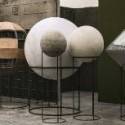
“Biennials are meant to ask questions”, says curator Ralph Rugoff at the press conference that opened the 13th Lyon Biennial, last September, with the title The Modern Life, which becomes one more event to review the modernist legacy, as in the Tate Triennial in 2009, curated by Nicolas Bourriaud.
“The idea of modern life, of course, starts with Baudelaire, and when I searched the topic on Google and found that there was only one show with that title, which was held in 1999, I thought it would be okay to work with that idea,” explained the American curator.
Director of the Hayward Gallery, a non-commercial space in London, Rugoff kicks off with the idea that “several trajectories of the modern project still affect and directly shape our perception,” to organise a show that addresses current and sensitive issues, especially in today’s Europe, as immigration and the use of technology.
In addition to these two themes, the exhibition has a more generic axis, which focuses on the everyday life in general. This Biennial, therefore, seeks to be face-to-face with the present. The perplexity of the present is discussed in the first work of the show, displayed on the Sucrière, an old sugar factory, with the installation by Chinese artist Liu Wei, Enigma. The art piece is literally a labyrinth of large volumes covered by truck tarps, simulating the buildings in large cities. So in Enigma one never sees the whole, a sensation of perplexity that points to one of the challenges of the so-called modern life and which permeates the 20th and 21st centuries.
Despite the fact that it starts off by inducing in the visitor a feeling of disorientation, the 13th Lyon Biennial is constructed on the grounds of a very clear message, with works on display in large spaces, without major interferences, even though the noise, as in big cities, constitute a factor somewhat destabilizing in some moments. The best example of that is the work of the French artist Céleste Boursier-Mougenot, who makes trees walk in the France Pavilion of the 56th Venice Biennial, open until November 22. In Lyon, Boursier-Mougenot participates with a work that resonates throughout the Sucrière, setting the tone of the show. It’s installed in the centre of the building: from above, at a slow pace, cherry seeds fall on top of a drum set – the musical instrument – causing the sound to reverberate throughout the exhibition space.

In addition to the factory of Sucrière, this edition continues to use the entire area of the Musée d’art Contemporain in Lyon: (MAC), which is, after all, the entity that created the Biennial, but the show is also extended to three other city institutions: Musée des Confluences, Parc de la Tête d›Or and the gallery of Institut Lumière.
The Lyon Biennial has a very particular history: it was created by the MAC Lyon director, Thierry Raspail, who personally selected the curators from all the Biennial editions, establishing one-word trilogies: History (1991, 1993 and 1995), Global (1997, 2000 and 2001), Temporality (2003, 2005 and 2007) and Transmission (2009, 2011 and 013). By doing so, the Biennial adopts a thematic that is closer to those of the museums, as it brings up questions and invests in the education of the public. For this reason, the theme of the 13th edition that opens this trilogy is Modern.
“Modern, refers to both the Neolithic period and the Bronze Age until its collapse, a little more than three thousand years ago,” explains Raspail, separating the concept from its most direct relation with art, which refers to period between the late 19th nineteenth and mid-twentieth century. “The concept of Modern disappeared sometime in the 1980s with the emergence of the Postmodern period, the end of the ‘long narratives’ and the end of what was thought of as the end of history,” added the director.
As the 13th Lyon Biennial seeks to address contemporary issues, it takes one closer to resembling other biennials, such as Venice, São Paulo and Istanbul, which also discuss aspects of the real world – although it does so in a less radical way. “As all good art, the Biennial is made up of complex works,” argues the curator. Among the most poetic pieces are the marble sculpture of the Greek Andreas Lolis, replicas of paper boxes and pieces of wood used by the homeless to build shelters. As he applies one of the noblest materials in art history, Lolis builds a memorial on the tragic facet of modern life.
*The journalist Fabio Cypriano traveled at the invitation of the 13th Biennial de Lyon organization
13th biennial de Lyon – Modern Life
through january 3 2016
labiennaledelyon.com

Deixe um comentário